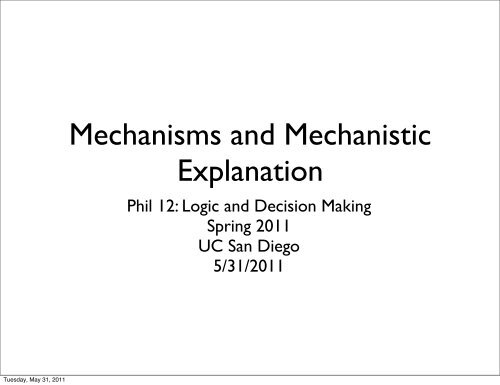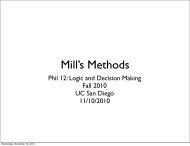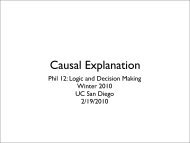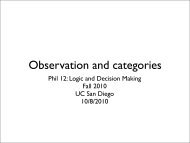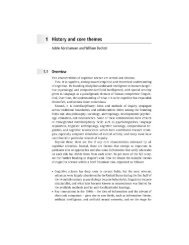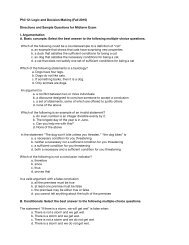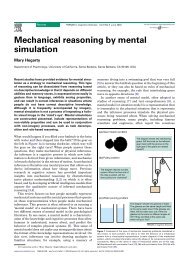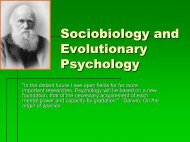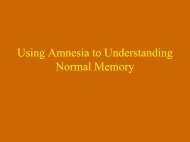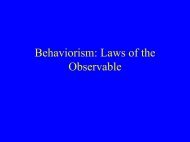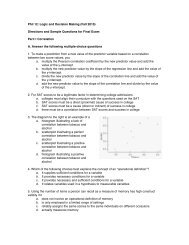Mechanisms and Mechanistic Explanation - UC San Diego
Mechanisms and Mechanistic Explanation - UC San Diego
Mechanisms and Mechanistic Explanation - UC San Diego
You also want an ePaper? Increase the reach of your titles
YUMPU automatically turns print PDFs into web optimized ePapers that Google loves.
Tuesday, May 31, 2011<br />
<strong>Mechanisms</strong> <strong>and</strong> <strong>Mechanistic</strong><br />
<strong>Explanation</strong><br />
Phil 12: Logic <strong>and</strong> Decision Making<br />
Spring 2011<br />
<strong>UC</strong> <strong>San</strong> <strong>Diego</strong><br />
5/31/2011
Tuesday, May 31, 2011<br />
CAPE deadline:<br />
8am Monday June 6th
Tuesday, May 31, 2011<br />
Office hours<br />
• Mitch: HSS 8037<br />
- Today:1-3pm<br />
- Tomorrow, Wed June 1st: 11am-1pm<br />
- Monday June 6th: 2-4pm <strong>and</strong> by appointment<br />
• Nat: HSS 7054<br />
- Thursday 1-3pm<br />
- Friday 2-4pm<br />
• Jeremy: HSS 7059<br />
- Friday 9-10am, 11am-12pm<br />
3
Tuesday, May 31, 2011<br />
Review - 1<br />
• Experiments provide the best evidence of a causal relation,<br />
but sometimes they are not possible<br />
- Because it is impossible physically or morally to<br />
manipulate the independent variable<br />
• Two strategies<br />
- Prospective studies<br />
• Divide groups according to the independent variable<br />
<strong>and</strong> investigate correlation with the dependent variable<br />
- Retrospective studies<br />
• Divide group according to the dependent variable <strong>and</strong><br />
investigate correlation with the independent variable
Tuesday, May 31, 2011<br />
Review - 2<br />
• All studies of causation are beset by confounds<br />
- Factors correlated with the independent variable that may<br />
themselves be the cause of the change in the dependent<br />
variable<br />
• By manipulating the independent variable in an experiment,<br />
researchers reduce the risk of confounds<br />
- Researchers can r<strong>and</strong>omize or match subjects or lock<br />
(control) procedural variables to minimize confounds<br />
• Prospective <strong>and</strong> retrospective experiments do not allow<br />
manipulation<br />
- Greater risk of confounds. Try to reduce the risk by:<br />
• matching subjects<br />
• measuring possible confounds
Imagine someone has traveled in time from 1885 to 2011<br />
<strong>and</strong> is trying to figure out how a car works. They do a series<br />
of experiments from the driver’s seat, without ever looking<br />
under the hood of the car, <strong>and</strong> conclude that turning the<br />
ignition key starts the car. Would you say this means they<br />
underst<strong>and</strong> how the car starts up?<br />
Tuesday, May 31, 2011<br />
A. Yes<br />
B. No<br />
C. Sort of<br />
Clicker question
Two limitations of causes for science<br />
•<br />
•<br />
•<br />
- It often requires a coordinated system of causes to<br />
- Typically there are processes intervening between<br />
Tuesday, May 31, 2011<br />
Individual causal relations do not accomplish much<br />
get something done<br />
What relates causes to their effects?<br />
causes <strong>and</strong> their effects<br />
Between <strong>and</strong> within causal relations scientists look<br />
for mechanisms:<br />
Parts (entities) <strong>and</strong> operations (activities)<br />
organized to produce a phenomenon
Tuesday, May 31, 2011<br />
The Ubiquity of <strong>Mechanisms</strong> in Science<br />
• <strong>Mechanisms</strong> in physical sciences<br />
- Solar system mechanics<br />
- <strong>Mechanisms</strong> of chemical reactions<br />
• <strong>Mechanisms</strong> in biological sciences<br />
- <strong>Mechanisms</strong> of photosynthesis<br />
- <strong>Mechanisms</strong> of reproduction<br />
• <strong>Mechanisms</strong> in behavioral sciences<br />
- <strong>Mechanisms</strong> of memory encoding<br />
- <strong>Mechanisms</strong> of decision making<br />
• <strong>Mechanisms</strong> in social sciences<br />
- <strong>Mechanisms</strong> of consensus formation
<strong>Mechanisms</strong> as Coordinated Causation<br />
Tuesday, May 31, 2011<br />
• <strong>Mechanisms</strong> are made of parts whose operations<br />
cause changes in other parts, enabling whole mechanisms<br />
to cause changes in yet other things<br />
- Muscles in heart contract while<br />
valves open <strong>and</strong> shut, enabling<br />
the heart to move blood<br />
through arteries <strong>and</strong> veins<br />
• Underst<strong>and</strong>ing a mechanism<br />
requires experimental<br />
procedures designed to figure out the parts, their causal<br />
operation, <strong>and</strong> how these operations are coordinated<br />
(organized) so that the mechanism can produce its effect
Tuesday, May 31, 2011<br />
Designing <strong>Mechanisms</strong> vs.<br />
Discovering <strong>Mechanisms</strong><br />
• The challenge in engineering is to design new mechanisms<br />
that produce the phenomena we are interested in<br />
- Typically, engineers begin with an objective <strong>and</strong> recruit<br />
parts already known to perform operations<br />
- Their challenge is to discover new modes of<br />
organization that enable the parts to together do<br />
something new<br />
• Scientists do not have access to the design manuals of the<br />
mechanisms operative in the natural world<br />
- They must reverse engineer them—discover the<br />
parts, the operations, <strong>and</strong> the organization
Tuesday, May 31, 2011<br />
Wedge<br />
Early machines:<br />
Variations on a theme<br />
Ramp<br />
Screw<br />
Early simple machines used human energy but extended<br />
its capacity<br />
- In these cases, shape <strong>and</strong> spatial layout explain the<br />
causal efficacy
Tuesday, May 31, 2011<br />
Early machines:<br />
Variations on another theme<br />
Lever<br />
Wheel<br />
Pulley<br />
In these cases, shape <strong>and</strong> layout together with<br />
coordination of parts explains the effect
Tuesday, May 31, 2011<br />
Simple mechanisms as tools to<br />
make tasks easier<br />
Permit the performance of activities that<br />
otherwise would not be possible
Tuesday, May 31, 2011<br />
Combining simple mechanisms<br />
Engineering: organizing<br />
components to produce effects
Tuesday, May 31, 2011<br />
From Simple to Complex<br />
• Common theme in both engineering <strong>and</strong><br />
science<br />
- Begin with simple designs but increasingly<br />
engineer or discover more <strong>and</strong> more<br />
complex mechanisms<br />
- Larger numbers of parts<br />
- Performing many different operations<br />
- Coordinated in ever more complex ways
Tuesday, May 31, 2011<br />
History of <strong>Mechanistic</strong><br />
Accounts in Science
Tuesday, May 31, 2011<br />
Nature as a machine:<br />
Rene Descartes (1596-1650)<br />
• “I have described this earth <strong>and</strong> indeed<br />
the whole universe as if it were a<br />
machine: I have considered only the<br />
various shapes <strong>and</strong> movements of its<br />
parts” (Principia IV 188).<br />
• All action in the physical universe due to<br />
shape <strong>and</strong> motion of physical matter<br />
- No vacuum<br />
- No action at a distance<br />
• Magnetism: Screw-shaped particles<br />
(formed in vortices) fit into threads in<br />
iron
Tuesday, May 31, 2011<br />
Restorer of the Mechanical Philosophy:<br />
Robert Boyle (1627-1691)<br />
• Introduced the name<br />
“mechanical philosophy”<br />
• Boyle’s law: “the hypothesis,<br />
that supposes the pressures<br />
<strong>and</strong> expansions to be in<br />
reciprocal proportion”<br />
- Air molecules as springs
•<br />
•<br />
•<br />
Tuesday, May 31, 2011<br />
- Animal bodies are purely<br />
Descartes:<br />
Animals as machines<br />
Impressed by the statuary in the<br />
Royal Gardens that moved by<br />
hydraulic principles<br />
mechanical devices<br />
Circulation of blood due to heating in<br />
the heart, causing the expansion of<br />
droplets of blood, which then forced<br />
their way through the arteries<br />
Nerve transmission <strong>and</strong> brain activity<br />
purely mechanical (albeit influenced<br />
by the mind in humans)
Tuesday, May 31, 2011<br />
Humans as machines<br />
• Descartes thought there were limits to<br />
what a mechanism could do:<br />
- couldn’t think or use language<br />
• Accordingly, held that the human<br />
capacity for thought was due to a non-<br />
material mind<br />
• Julien Offray de La Mettrie objected that<br />
Descartes did not go far enough—all<br />
human activities, including thinking<br />
explained in mechanical terms<br />
- Man the Machine in 1748
Newton: Exp<strong>and</strong>ing the<br />
J,
Tuesday, May 31, 2011<br />
Jacques de Vaucanson (1709-1782):<br />
“Moving Anatomy”<br />
?%)T#,'(2,(U%#)%&'0&<br />
?%)T#,'(2,(<br />
• Mechanical duck created in 1739<br />
- could !"#$%&'#%()*+#,)<br />
move in the typical, wagging way of<br />
a duck<br />
- eat <strong>and</strong> "%0)%&*)*'5"70)6'7$<br />
digest fish<br />
-<br />
"8#9"0")0$")9".%'&7)'&)%):&%0+9%(:)4%1)<br />
excrete the remains in a "natural" way<br />
!"#$%&'7.)4%7)*9'/"&);1)%)4"'5$0<br />
• Mechanism was driven by a weight<br />
• Consisted 2%9073)#-&#"%("*)'&7'*")0$")*+#,)%&*)0$")<br />
of more than a thous<strong>and</strong> moving<br />
parts, ;%7")-&)4$'#$)0$");'9*)70--*)<br />
concealed inside the duck <strong>and</strong> the<br />
base on ="7'*"7)0$")*+#,3)%)6(+0")%&*)0%.;-+9'&")<br />
which the bird stood<br />
• Besides the duck, a flute <strong>and</strong> tambourine<br />
player<br />
U%#)%&'0& VG!WX>G!IYZK<br />
VG!WX G!IYZK<br />
MB03+&6(8&%/0$9R<br />
#-+(*).-/")'&)0$")012'#%(3)4%55'&5)4%1)-6)<br />
%)*+#,<br />
Tuesday, May 31, 2011<br />
Applying mechanical ideas to living<br />
organisms<br />
• Living things seem to behave in<br />
complex ways that defy simple<br />
mechanical explanation<br />
• Vitalists maintained that the<br />
complexity <strong>and</strong> purposiveness of<br />
biological processes made<br />
mechanical explanation impossible<br />
• Mechanists developed more<br />
complex conceptions of<br />
mechanisms
•<br />
Tuesday, May 31, 2011<br />
Tropism<br />
Two principles of Jacques Loeb (1859-1924):<br />
(i) The movements of an organism to or from<br />
a center of a stimulus are caused by action<br />
of the stimulus on the receptors, <strong>and</strong><br />
through these on the organs of<br />
locomotion, in consequence of which the<br />
animal turns until its body is symmetrically<br />
stimulated <strong>and</strong> an equilibrium obtained<br />
between the two sides.<br />
(ii) These movements occur mechanically, as a<br />
result of physical <strong>and</strong> chemical changes in<br />
the receptors <strong>and</strong> effectors, with no real<br />
effort on the part of the organism.
Tuesday, May 31, 2011<br />
Designing a tropistic machine<br />
+<br />
+<br />
+<br />
+<br />
+<br />
+<br />
+<br />
+<br />
+<br />
+
Tuesday, May 31, 2011<br />
Designing a tropistic machine<br />
+<br />
+<br />
+<br />
+<br />
+<br />
+<br />
+<br />
+<br />
+<br />
+<br />
+<br />
+
Tuesday, May 31, 2011<br />
Characterizing<br />
<strong>Mechanisms</strong>
Which of the following is not a necessary feature of a<br />
mechanism?<br />
Tuesday, May 31, 2011<br />
Clicker question<br />
A. A phenomenon<br />
B. A designer<br />
C. Component parts performing operations<br />
D. Organization
Tuesday, May 31, 2011<br />
Characterizing mechanisms<br />
• Start with a phenomenon of interest:<br />
- tropism of plants<br />
- cell division<br />
- remembering events in one’s life<br />
- increasing worker productivity
Describing the Phenomenon<br />
•<br />
•<br />
•<br />
Tuesday, May 31, 2011<br />
- Otherwise one risks trying to explain something that<br />
- Before seeking a mechanism by which the universe<br />
- Before seeking a mechanism to explain global<br />
Before setting out to explain a phenomenon, need to<br />
characterize it as accurately as possible<br />
might not be possible<br />
An important role for purely observational research<br />
continues to exp<strong>and</strong>, make sure it does exp<strong>and</strong><br />
warming, make sure it is really occurring<br />
But the description of the phenomena may be revised in<br />
the process of figuring out the mechanism
Tuesday, May 31, 2011<br />
<strong>Mechanisms</strong> have working parts<br />
• To underst<strong>and</strong> a mechanism, one must<br />
decompose it: take it apart<br />
- Literally<br />
- Figuratively<br />
• In identifying components, focus both on their<br />
- Structure<br />
- Function
Structural components of cells<br />
Cell components tend<br />
to have boundaries<br />
(membranes) that<br />
restrict access<br />
Components have<br />
distinctive<br />
appearances, especially<br />
when stained<br />
Worry—since things have to be manipulated to be seen, is<br />
what you see reflective of what is there?<br />
Tuesday, May 31, 2011<br />
Or is it a product of your manipulation: an artifact
Tuesday, May 31, 2011<br />
What are the parts of the brain?<br />
• Open up the skull, <strong>and</strong> you<br />
see a hunk of grey matter<br />
highly convoluted<br />
• What are the operating<br />
parts of the brain?<br />
Sulci <strong>and</strong><br />
Gyri?<br />
Lobes?
Tuesday, May 31, 2011<br />
What are the working parts of the brain?<br />
• Korbinian Brodmann (1909) assumed differences in<br />
neuron type, density, layering, probably related to function<br />
Delineated areas in the brains of humans <strong>and</strong> many other<br />
species
What are the working parts of the brain?<br />
Tuesday, May 31, 2011<br />
• With improved tools, including tools for tracing<br />
the connectivity of neural processes (axons <strong>and</strong><br />
dendrites), modern brain mappers have developed<br />
maps that seem to correspond to function
Tuesday, May 31, 2011<br />
What operations do the<br />
components perform?<br />
• Just locating <strong>and</strong> isolating a component doesn’t<br />
reveal what the component does<br />
• Sometimes probing a item in various ways will<br />
reveal what it does
Tuesday, May 31, 2011<br />
What operations do the<br />
components perform?<br />
• Often one must reason backwards from what the<br />
whole mechanism does to what operations are<br />
needed to perform that activity<br />
• Often these operations are not obvious<br />
- Reverse engineering<br />
- Figuring out what task needs to be performed<br />
- Using information about the type of operations that<br />
have been previously identified in similar systems<br />
- Drawing upon analogies with machines made by<br />
humans
Tuesday, May 31, 2011<br />
What operations do the<br />
• Strategies:<br />
- Recording studies<br />
- Lesion studies<br />
- Excitation studies<br />
components perform?
Tuesday, May 31, 2011<br />
Organization<br />
• Grains of s<strong>and</strong> in a s<strong>and</strong> pile<br />
are not organized: you can<br />
recombine the grains at will<br />
<strong>and</strong> nothing happens<br />
• In mechanisms, one part depends on others, so<br />
organization matters
Tuesday, May 31, 2011<br />
Organization is critical to the<br />
operation of a lock
Organization even more important in a<br />
Tuesday, May 31, 2011<br />
system of active components
Tuesday, May 31, 2011<br />
Diagramming Spatial Organization
Diagramming steps in a process<br />
Tuesday, May 31, 2011


